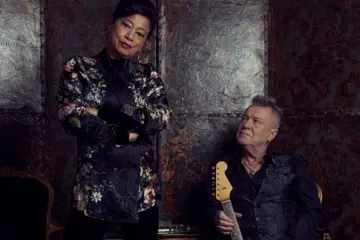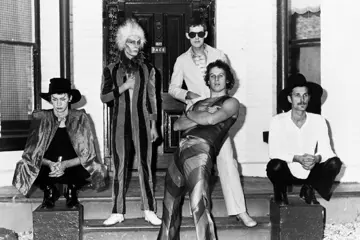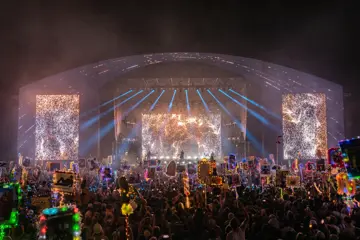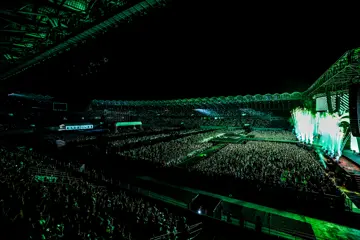A few weeks ago, Townsville-based dance company Dancenorth unveiled a new work at the Brisbane Festival. Dust, created by the company’s two artistic leaders Kyle Page and Amber Haines, is a stunning and shattering treatise on the cultural, political, and ideological schisms that fracture our society and subvert our shared humanity. Since seeing that production, much of its starkest imagery has persisted in my mind: a blade-like wall ghettoising the two halves of the stage; a trembling mass of bodies, huddled and herded into an overcrowded vessel; a brutalist skyline dwarfing fragile human forms.
Dust consciously grapples with current geopolitics, but ultimately it reveals more about human empathy than it does about protest. Nonetheless, it’s impossible to ignore the outrage contained within its semiotics; political fury is now not so much a source of inspiration as it is an inescapable mandate, not just for creatives but for society at large. It’s unsurprising that so many artists have found themselves channelling these divisive anxieties through the lens of their craft, creating works that rail against inequity and howl for justice.
But polemic fire is not the only impetus empowering artists today. One Infinity, another new work by Dancenorth in collaboration with Beijing Dance Theatre, is orbited by the same political concerns. And yet, where we might expect conflict, this profoundly beautiful and galvanising production offers compassion, championing communion over division and cultural exchange over isolationist fear.
Created by choreographer Gideon Obarzanek in partnership with artists from both Australia and China, including virtuoso recorder player and composer Genevieve Lacey, One Infinity does not merely present concepts of unity but multiplies them, refracts them, and ritualises them until the very fabric of the performance is transformed. And perhaps ironically, this is most strikingly achieved through the production’s oppositional design.
Seated on raked banks of benches facing each other across a glossy, rectangular stage, the two opposing groups of audience members are tasked with repeating short sequences of choreographed gestures at certain moments in the production, mirroring cues from strategically placed performers. The result is participation that, far from feeling intimidating or forced, is utterly transformative. The simple yet mercurial movements riff on ideas of salutation, sometimes playfully, like the wiggling of fingers, sometimes with a sense of yearning or urgency. With the fourth wall dismantled and the boundaries between passive observer and active participant blurred, the audience’s immersive connection to the work becomes supercharged. Rarely have I experienced such an alert communication between a performance and its recipients, accomplished so successfully.
Also seated, two small ensembles of dancers emerge from the audience. At first, they are distinctly separate, spatially, visually and culturally; the Australian performers clad in desert-red on one side, their Chinese counterparts in jade-green directly opposite. An antiphonal exchange begins. The gentle fluidity of each small group’s combined movements creates a collective superorganism, blossoming and contracting with perfect, detailed symmetry.
This hypnotic display is steeped in suggestive symbolism: the primordial, aquatic origins of all biological things; the birth canal as a universal image of humanity’s shared beginnings; the sensual desires that can cross cultures and defy heritage. Each evolving notion seems to deconstruct the societal divides and taboos that restrain our most essential natures, until the two groupings, Eastern and Western, coalesce into a single harmonious collective.
But while Obarzanek's dance celebrates those things, both physical and emotional, that unify us as a species, One Infinity’s score, created by Genevieve Lacey, Max de Wardner and Wang Peng, is an exploration of cultural distinctiveness. As if rejecting the mono-cultural, multi-ethnic homogenisation that has become the reality of modern multiculturalism, this richly layered music conjures a sound world that is at once familiar and yet unexpected. Performed by an on-stage ensemble of traditional Chinese instruments alongside Lacey on recorder, artfully blended with additional electronic elements, ancient references mingle with new, exotic combinations of sonorities, superimposing geography, history, tradition and invention in ever-shifting chimeric patterns.
It's important to note that purely as a work of art, this is a collaboration of staggering ambition, realised with a level of finesse that makes it a privilege to experience in its own right, without the need for any didactic underscoring. But for those willing to engage with its subtext, One Infinity has a powerfully affirming political spirit as well: a deeply moving, reflective statement reaching far beyond the xenophobia that is such an insistent presence in the world, revealing the borderless wonders that are possible through open-hearted, compassionate curiosity.
Melbourne International Arts Festival presents Dancenorth and Beijing Dance Theatre's One Infinity, until 20 Oct at Malthouse Theatre















